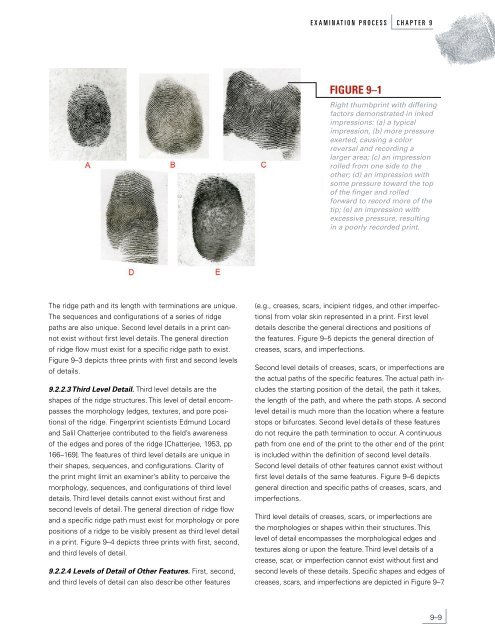John R. Vanderkolk - National Criminal Justice Reference Service
John R. Vanderkolk - National Criminal Justice Reference Service
John R. Vanderkolk - National Criminal Justice Reference Service
Create successful ePaper yourself
Turn your PDF publications into a flip-book with our unique Google optimized e-Paper software.
The ridge path and its length with terminations are unique.<br />
The sequences and configurations of a series of ridge<br />
paths are also unique. Second level details in a print cannot<br />
exist without first level details. The general direction<br />
of ridge flow must exist for a specific ridge path to exist.<br />
Figure 9–3 depicts three prints with first and second levels<br />
of details.<br />
9.2.2.3 Third Level Detail. Third level details are the<br />
shapes of the ridge structures. This level of detail encompasses<br />
the morphology (edges, textures, and pore positions)<br />
of the ridge. Fingerprint scientists Edmund Locard<br />
and Salil Chatterjee contributed to the field’s awareness<br />
of the edges and pores of the ridge [Chatterjee, 1953, pp<br />
166–169]. The features of third level details are unique in<br />
their shapes, sequences, and configurations. Clarity of<br />
the print might limit an examiner’s ability to perceive the<br />
morphology, sequences, and configurations of third level<br />
details. Third level details cannot exist without first and<br />
second levels of detail. The general direction of ridge flow<br />
and a specific ridge path must exist for morphology or pore<br />
positions of a ridge to be visibly present as third level detail<br />
in a print. Figure 9–4 depicts three prints with first, second,<br />
and third levels of detail.<br />
9.2.2.4 Levels of Detail of Other Features. First, second,<br />
and third levels of detail can also describe other features<br />
E X A M I N A T I O N P R O C E S S C H A P T E R 9<br />
FIGURE 9–1<br />
Right thumbprint with differing<br />
factors demonstrated in inked<br />
impressions: (a) a typical<br />
impression, (b) more pressure<br />
exerted, causing a color<br />
reversal and recording a<br />
larger area; (c) an impression<br />
rolled from one side to the<br />
other; (d) an impression with<br />
some pressure toward the top<br />
of the finger and rolled<br />
forward to record more of the<br />
tip; (e) an impression with<br />
excessive pressure, resulting<br />
in a poorly recorded print.<br />
(e.g., creases, scars, incipient ridges, and other imperfections)<br />
from volar skin represented in a print. First level<br />
details describe the general directions and positions of<br />
the features. Figure 9–5 depicts the general direction of<br />
creases, scars, and imperfections.<br />
Second level details of creases, scars, or imperfections are<br />
the actual paths of the specific features. The actual path includes<br />
the starting position of the detail, the path it takes,<br />
the length of the path, and where the path stops. A second<br />
level detail is much more than the location where a feature<br />
stops or bifurcates. Second level details of these features<br />
do not require the path termination to occur. A continuous<br />
path from one end of the print to the other end of the print<br />
is included within the definition of second level details.<br />
Second level details of other features cannot exist without<br />
first level details of the same features. Figure 9–6 depicts<br />
general direction and specific paths of creases, scars, and<br />
imperfections.<br />
Third level details of creases, scars, or imperfections are<br />
the morphologies or shapes within their structures. This<br />
level of detail encompasses the morphological edges and<br />
textures along or upon the feature. Third level details of a<br />
crease, scar, or imperfection cannot exist without first and<br />
second levels of these details. Specific shapes and edges of<br />
creases, scars, and imperfections are depicted in Figure 9–7.<br />
9–9

















